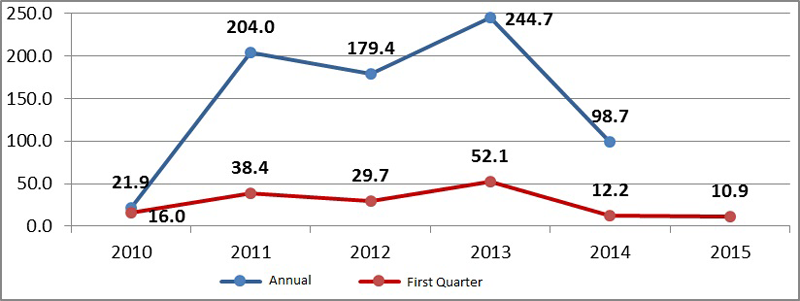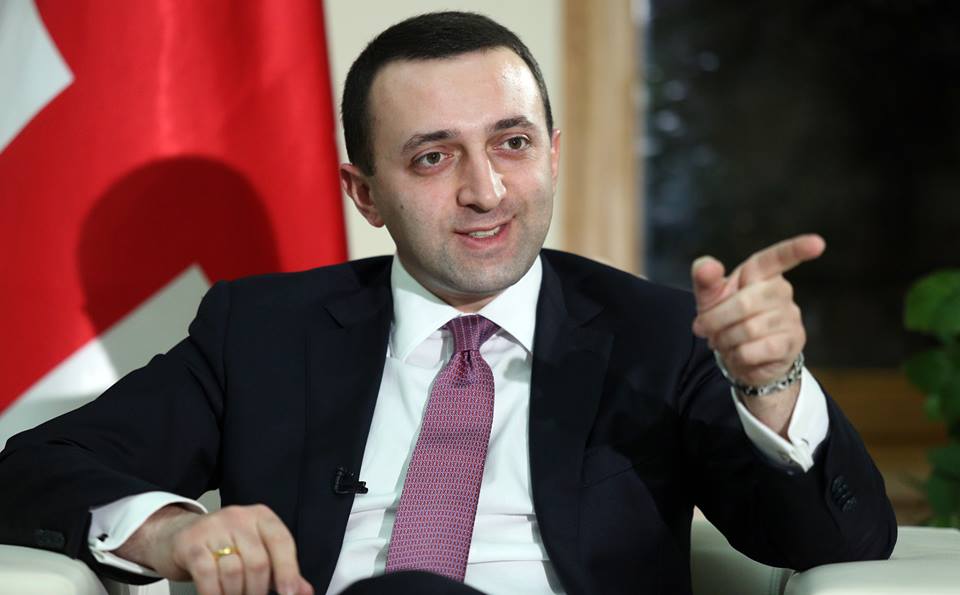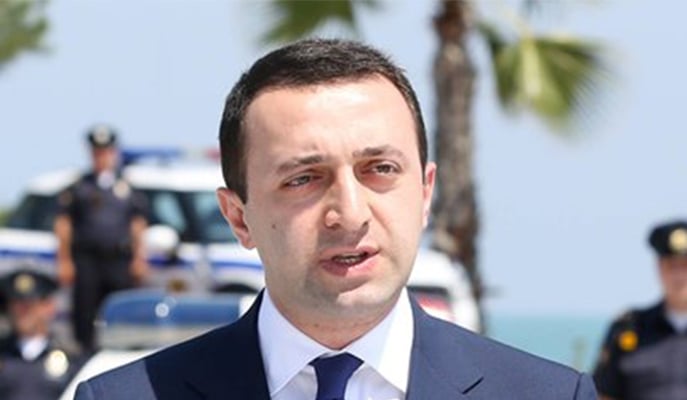At a government press conference about the electricity price hike, the Prime Minister of Georgia, Irakli Gharibashvili, stated that three years ago, as a result of the decrease in the price of electricity by GEL 0.04, the people of Georgia have managed to save GEL 150 million. The Prime Minister believes that this is the amount of money which has been paid in excess by the population for years.
From the beginning, we have to say that the imposition of an artificially low price for any type of product will result in increased savings for the consumer at the expense of decreased gains for the producer. In the case of the price of electricity, the profits which were then invested back into the energy sector by the energy producers became savings for the consumer which in turn were used to purchase other types of products. However, the precondition for the long-term development of a country is investment savings and not the purchase of additional consumer goods. Of note is that 65% of the money spent for consumer goods in Georgia goes towards imported products. The decrease in prices for any type of product is positive and welcoming but only if it happens naturally as a result of a decrease in production costs or due to increased competition.
The Georgian electricity market is peculiar because it has only one supplier (Telasi in Tbilisi and EnergoPro in the regions) and there is no competition. Therefore, the state has to get involved in the determination of electricity prices. The consumer price for electricity is determined by the Georgian National Energy and Water Supply Regulatory Commission (GNEWSRC). The GNEWSRC takes into account the cost of the production of electricity, tariffs for distribution and the share of profit of the energy companies in order to determine the price of electricity.
In 2006, the price of electricity was increased significantly and rose from GEL 0.1 to GEL 0.15 on average. With the higher price, the population started to consume less electricity which ultimately created a 24/7 electricity supply following the surplus. In 2007, the volume of generated electricity in Georgia rose by 300% as compared to 2006. Of this amount, the volume of energy generated by hydro resources increased by 377%.
The decrease in the price of electricity was one of the promises of the Georgian Dream during the election campaign. At the end of 2012, both GNEWSRC and energy companies "were given the task" of finding the means to lower the price of electricity. The price of electricity did indeed decrease from 1 January 2013. For residential consumers, the price of electricity for less than 300 kW/h dropped by GEL 0.0354 whilst for those who consume more than 300 kW/h the price went down by GEL 0.027. The price remained the same for legal entities.
The price of electricity was largely decreased at the expense of the profit share of energy companies and, in exchange, their investment obligations were also lessened. On 25 July 2015, on the Rustavi 2 evening news broadcast, the former Head of GNEWSRC, Guram Chalagashvili, discussed the decision of 2012 with regard to the decrease in the prices of electricity. Mr Chalagashvili stated: "The contracts with the energy companies which were cancelled used to oblige these companies to invest hundreds of millions in the field of energy."
The drop in the price was reflected in the volume of investments attracted in the energy sector. In 2014, the amount of foreign direct investments in the field of energy was 45% less as compared to 2012. In the first quarter of 2015, the amount of investments decreased even further with the total amount reaching only GEL 11 million. This number is 10.4% less than the same indicator of the previous year and 63% less than the number of the first quarter of 2012.
Graph 1:
Annual and Quarterly Indicators of Foreign Direct Investments Attracted in the Field of Energy

In 2014, the current account balance for the foreign trade of electricity also worsened. The deterioration was caused by the increase in the volume of imported electricity. In 2014, the amount of imported electricity was 64% higher as compared to 2013.
Table 1:
Current Account Balance for Foreign Trade of Electricity
| kW/h millions | 2011 | 2012 | 2013 | 2014 | 2015 (6 months) |
| Import | 471 | 615 | 484 | 793 | 349.5 |
| Export | -931 | -528 | -450 | -545 | -400 |
| Balance | 460 | -86 | -34 | -248 | 51 |
The significant depreciation of GEL in the last months has caused additional problems for the energy sector. As of 2014, the share of imported energy in Georgia’s total domestic consumption is 7.7%. However, in the first half of 2015, it was 6%. Approximately 19% of consumed electricity is generated by combined cycle power plants which use imported natural gas for the generation of electricity. The depreciation of GEL makes imported electricity, together with the natural gas required for the operation of the combined cycle power plants, more expensive.
Table 2:
Supply of Electricity (kW/h Million)
| Supply of Electricity (kW/h Million) | 2006 | 2007 | 2008 | 2009 | 2010 | 2011 | 2012 | 2013 | 2014 | 2015 (6 months) |
| Generation | 2,757 | 8,346 | 8,451 | 8,408 | 10,057 | 10,105 | 9,695 | 10,059 | 10,370 | 5,575 |
| Combined Cycle Power Plants | 945 | 1,515 | 1,282 | 991 | 683 | 2,212 | 2,472 | 1,788 | 2,036 | 1,102 |
| Supply Share | 34.4% | 17.6% | 14.4% | 11.6% | 6.7% | 21.3% | 24.5% | 17.3% | 18.5% | 19.0% |
| Hydro Power Plants | 1,813 | 6,831 | 7,169 | 7,417 | 9,375 | 7,892 | 7,223 | 8,271 | 8,334 | 4,473 |
| Supply Share | 66.0% | 79.4% | 80.3% | 86.9% | 92.4% | 76.0% | 71.6% | 80.0% | 75.7% | 77.1% |
| Import | 60 | 433 | 649 | 255 | 222 | 471 | 615 | 484 | 852 | 350 |
| Supply Share | 2.2% | 5.0% | 7.3% | 3.0% | 2.2% | 4.5% | 6.1% | 4.7% | 7.7% | 6.0% |
| Total Resources | 2,817 | 8,779 | 9,100 | 8,663 | 10,280 | 10,575 | 10,309 | 10,543 | 11,222 | 5,925 |
| Losses | 72 | 176 | 169 | 130 | 139 | 192 | 226 | 198 | 216 | 125 |
| Network Supply | 2,745 | 8,603 | 8,930 | 8,533 | 10,141 | 10,383 | 10,087 | 10,345 | 11,006 | 5,800 |
Due to the fact that purchase transactions are accomplished in USD, the depreciation of GEL is proportionally reflected in the price of natural gas purchased by the combined cycle power plants and on the imported electricity. Besides the currency exchange rate, the fluctuation of prices in USD is also important. In this regard, we witness an upward trend on imported electricity.
Since 2012, the average annual exchange rate of GEL depreciated by 32%. At the same time, after 2012, the price for 1 kW/h of imported energy increased by USD 0.123 (23%). Together, the depreciation of GEL and the price hike for imported energy resulted in the increase of the price for 1 imported kW/h by GEL 0.055 (62%).
The consumer price is more affected by the cost of electricity generated by combined cycle power plants than by the price of imported energy. Of the total amount of consumed energy, 19% is generated by combined cycle power plants. The price of natural gas in USD is constant but due to the depreciation of GEL, the combined cycle power plants have to pay 32% more GEL per each cubic metre of purchased natural gas.
The companies which suffered from the increase in the cost of energy, EnergoPro and Telasi, appealed to GNEWSRC with an official request to increase the consumer price. At the 23 July session, GNEWSRC decided to increase the electricity price for consumers. As a result, the price for 1 kW/h increased by GEL 0.035 for every category of consumers in the regions. However, EnergoPro requested a price increase of GEL 0.045. At the GNEWSRC meeting on 24 August, the Commission gave a presentation according to which the possible price of purchase for Telasi was determined to be GEL 0.112 for 1 kW/h from September 2015 to January 2016. At the present moment, the average weighted price of purchase is GEL 0.055 for 1 kW/h.
Table 3:
EnergoPro Changes in Consumer Prices
| Changes of Consumer Prices | Price until 2013 (kW/h) | Price from 2013 until August 2015 (kW/h | Price from August 2015 (kW/h) |
| 0–101 kW/h | 12.98 | 7.63 | 10.978 |
| 101–301 kW/h | 16.52 | 11.00 | 14.348 |
| 301 kW/h and more | 17.5 | 14.83 | 18.178 |
The Government of Georgia decided to subsidise the increased price for socially vulnerable families which will result in increased budget expenses. Naturally, subsidies are not a way to make the energy sector healthier and to improve the general economic situation. If we take into account that one of the reasons for the depreciation of GEL is the periodic spending of a great deal of money from the budget together with taking domestic debt, it is more likely that the subsidies will increase the risks for currency instability. Therefore, there is the probability for an even further increase in the prices of electricity.
Conclusion
In 2006, the price of electricity in Georgia rose considerably. As a result, it became possible to have a 24/7 energy supply throughout the country whilst the energy sector became more attractive for investors. In exchange for the increased prices, supply companies were obligated to invest in the energy sector.
One of the promises of the Georgian Dream election campaign was a decrease in the prices of electricity. After 1 January 2013, the consumer price did indeed decrease by GEL 0.354. The drop in prices was largely accomplished at the expense of decreased profit margins for the supply companies together with a drop in their investment obligations. As a result, the growth rate of domestic production started to lag behind energy consumption and Georgia’s dependency upon imported energy increased. In the last months, due to the significant depreciation of GEL, the price of imported electricity together with that generated by combined cycle power plants has increased. As a result, GNEWSRC had to increase the price for EnergoPro by GEL 0.035 whilst Telasi’s price increase is planned to be GEL 0.057.
The Prime Minister declared that the energy price before 2013 was "excessive" and talked about the savings made by the population as a result of the drop in price in the last years. Of note is that the "savings" for the population represent a loss for energy producers and in this case they were deducted from future investments in the energy sector. The "excessive" amount of money paid for electricity was actually one of the preconditions for the development of the energy sector. The decrease in the price, however, hampered this development. The investment savings of the producer were transformed into savings for consumers which were spent for the purchase of other products and, eventually, were not positively reflected in the long-term economic development of the country.
FactCheck concludes that the Prime Minister’s statement, "Three years ago, as a result of the decrease in electricity prices, our population managed to save GEL 150 million. That is the amount of money which they have been paying in excess for years," is MOSTLY FALSE.








